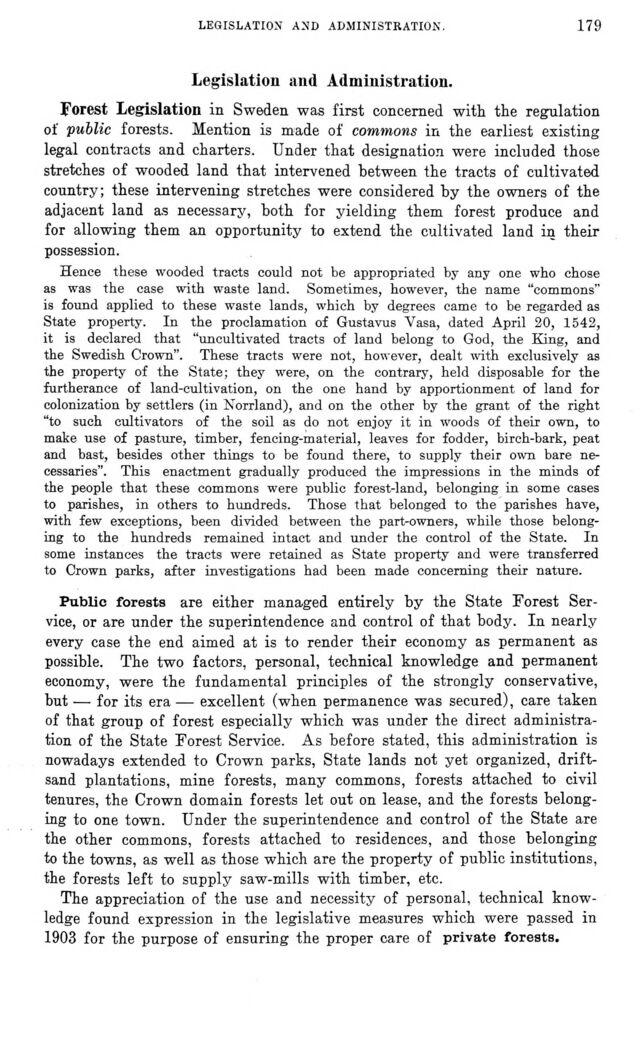
Full resolution (JPEG) - On this page / på denna sida - IV. Forestry - 1. Forests. By Th. Örtenblad

<< prev. page << föreg. sida << >> nästa sida >> next page >>
Below is the raw OCR text
from the above scanned image.
Do you see an error? Proofread the page now!
Här nedan syns maskintolkade texten från faksimilbilden ovan.
Ser du något fel? Korrekturläs sidan nu!
This page has never been proofread. / Denna sida har aldrig korrekturlästs.
legislation and administration.
179
Legislation and Administration.
Forest Legislation in Sweden was first concerned with the regulation
of public forests. Mention is made of commons in the earliest existing
legal contracts and charters. Under that designation were included those
stretches of wooded land that intervened between the tracts of cultivated
country; these intervening stretches were considered by the owners of the
adjacent land as necessary, both for yielding them forest produce and
for allowing them an opportunity to extend the cultivated land in their
possession.
Hence these wooded tracts could not be appropriated by any one who chose
as was the case with waste land. Sometimes, however, the name "commons"
is found applied to these waste lands, which by degrees came to be regarded as
State property. In the proclamation of Gustavus Yasa, dated April 20, 1542,
it is declared that "uncultivated tracts of land belong to God, the Bang, and
the Swedish Crown". These tracts were not, however, dealt with exclusively as
the property of the State; they were, on the contrary, held disposable for the
furtherance of land-cultivation, on the one hand by apportionment of land for
colonization by settlers (in Norrland), and on the other by the grant of the right
"to such cultivators of the soil as do not enjoy it in woods of their own, to
make use of pasture, timber, fencing-material, leaves for fodder, birch-bark, peat
and bast, besides other things to be found there, to supply their own bare
necessaries". This enactment gradually produced the impressions in the minds of
the people that these commons were public forest-land, belonging in some cases
to parishes, in others to hundreds. Those that belonged to the parishes have,
with few exceptions, been divided between the part-owners, while those
belonging to the hundreds remained intact and under the control of the State. In
some instances the tracts were retained as State property and were transferred
to Crown parks, after investigations had been made concerning their nature.
Public forests are either managed entirely by the State Forest
Service, or are under the superintendence and control of that body. In nearly
every case the end aimed at is to render their economy as permanent as
possible. The two factors, personal, technical knowledge and permanent
economy, were the fundamental principles of the strongly conservative,
but — for its era — excellent (when permanence was secured), care taken
of that group of forest especially which was under the direct
administration of the State Forest Service. As before stated, this administration is
nowadays extended to Crown parks, State lands not yet organized,
drift-sand plantations, mine forests, many commons, forests attached to civil
tenures, the Crown domain forests let out on lease, and the forests
belonging to one town. Under the superintendence and control of the State are
the other commons, forests attached to residences, and those belonging
to the towns, as well as those which are the property of public institutions,
the forests left to supply saw-mills with timber, etc.
The appreciation of the use and necessity of personal, technical
knowledge found expression in the legislative measures which were passed in
1903 for the purpose of ensuring the proper care of private forests.
<< prev. page << föreg. sida << >> nästa sida >> next page >>